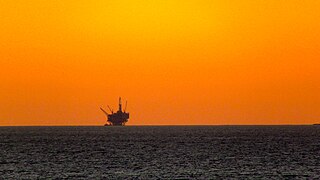
An oil platform, offshore platform, or offshore drilling rig is a large structure with facilities for well drilling to explore, extract, store, process petroleum and natural gas which lies in rock formations beneath the seabed. In many cases, the platform contains facilities to house the workforce as well.

Offshore construction is the installation of structures and facilities in a marine environment, usually for the production and transmission of electricity, oil, gas and other resources. It is also called maritime engineering.
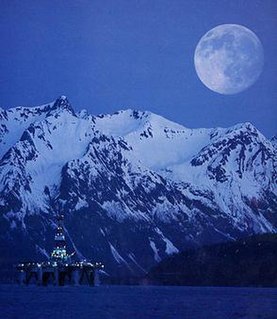
Ocean Ranger was a semi-submersible mobile offshore drilling unit that sank in Canadian waters on 15 February 1982. It was drilling an exploration well on the Grand Banks of Newfoundland, 267 kilometres (166 mi) east of St. John's, Newfoundland, for Mobil Oil of Canada, Ltd. (MOCAN) with 84 crew members on board when it sank. There were no survivors.
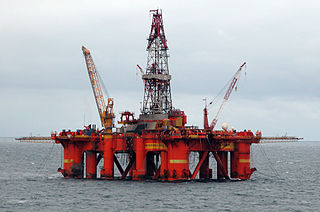
A semi-submersible platform is a specialised marine vessel used in a number of specific offshore roles including as offshore drilling rigs, safety vessels, oil production platforms, and heavy lift cranes. They are designed with good stability and seakeeping characteristics. Other terms for these platforms include semi-submersible, semi-sub, or simply semi.

Alexander L. Kielland was a Norwegian semi-submersible drilling rig that capsized while working in the Ekofisk oil field in March 1980, killing 123 people. It was a platform of the Pentagone series.

LP Odyssey is a self-propelled semi-submersible mobile spacecraft launch platform converted from a mobile drilling rig in 1997.

A tension-leg platform (TLP) or extended tension leg platform (ETLP) is a vertically moored floating structure normally used for the offshore production of oil or gas, and is particularly suited for water depths greater than 300 metres and less than 1500 metres. Use of tension-leg platforms has also been proposed for wind turbines.
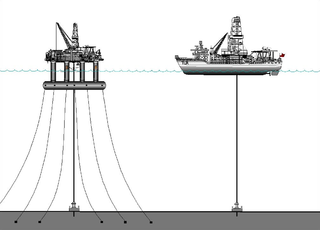
A drillship is a merchant vessel designed for use in exploratory offshore drilling of new oil and gas wells or for scientific drilling purposes. In most recent years the vessels are used in deepwater and ultra-deepwater applications, equipped with the latest and most advanced dynamic positioning systems.

A liftboat is a self-propelled, self-elevating vessel with a relatively large open deck capable of carrying equipment and supplies in support of various offshore mineral exploration and production or offshore construction activities. A liftboat also has the capability of rapidly raising its hull clear of the water on its own legs so as to provide a stable platform from which maintenance and construction work may be conducted.

Very large floating structures (VLFSs) or very large floating platforms (VLFPs) are manmade islands, which may be constructed to create floating airports, bridges, breakwaters, piers and docks, storage facilities, wind and solar power plants, for military purposes, to create industrial space, emergency bases, entertainment facilities, recreation parks, mobile offshore structures and even for habitation. Currently, several different concepts have been proposed for building floating cities or huge living complexes. Some units have been constructed and are presently in operation.
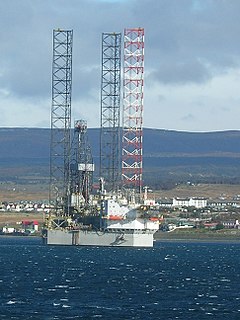
A jackup rig or a self-elevating unit is a type of mobile platform that consists of a buoyant hull fitted with a number of movable legs, capable of raising its hull over the surface of the sea. The buoyant hull enables transportation of the unit and all attached machinery to a desired location. Once on location the hull is raised to the required elevation above the sea surface supported by the sea bed. The legs of such units may be designed to penetrate the sea bed, may be fitted with enlarged sections or footings, or may be attached to a bottom mat. Generally jackup rigs are not self-propelled and rely on tugs or heavy lift ships for transportation.

A heavy-lift ship is a vessel designed to move very large loads that cannot be handled by normal ships. They are of two types:
Deepwater drilling, or Deep well drilling, is the process of creating holes by drilling rig for oil mining in deep sea. There are approximately 3400 deepwater wells in the Gulf of Mexico with depths greater than 150 meters.
Offshore concrete structures have been in use successfully for about 30 years. They serve the same purpose as their steel counterparts in the oil and gas production and storage. The first concrete oil platform has been installed in the North Sea in the Ekofisk field in 1973 by Phillips Petroleum. Since then 47 major concrete offshore structures have been built, whereby 21 of the 47 concrete substructures have been designed by Dr. techn. Olav Olsen.
Transocean Marianas is an Earl & Wright Sedco 700 design semi-submersible drilling unit capable of operating in harsh environments and water depths up to 7,000 feet (2,100 m) using an 47.6 cm (18.75 in), 15,000 psi blowout preventer (BOP), and a 53 cm (21 in) outside diameter (OD) marine riser.

Scarabeo 8 is an ultra deepwater 6th generation semi-submersible drilling rig. It is owned and operated by Saipem. The vessel is registered in Nassau, Bahamas.

Kulluk was an ice-strengthened drill barge that was used for oil exploration in the Arctic waters. She was constructed by Mitsui Engineering & Shipbuilding in Japan in 1983 and operated in the Canadian Arctic until 1993 when she was mothballed for over a decade. In 2005, she was purchased and extensively refurbished by Royal Dutch Shell for the drilling operations off the northern coast of Alaska.
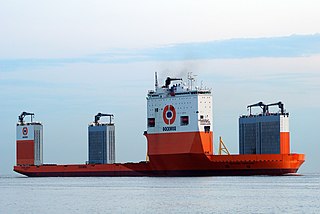
BOKA Vanguard is a semi-submersible heavy lift ship owned and operated by Dockwise B.V. Dockwise Vanguard is the largest vessel of her type ever built, and is able to carry cargoes up to 110,000 tonnes. Dockwise Vanguard was designed to move offshore oil and gas facilities, but can also carry other ships and act as an offshore dry dock facility.















